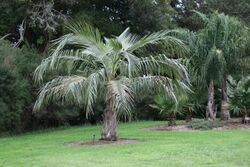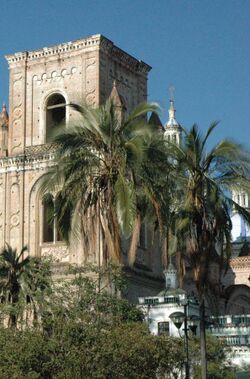Biology:Parajubaea cocoides
| Parajubaea cocoides | |
|---|---|

| |
| Scientific classification | |
| Kingdom: | Plantae |
| Clade: | Tracheophytes |
| Clade: | Angiosperms |
| Clade: | Monocots |
| Clade: | Commelinids |
| Order: | Arecales |
| Family: | Arecaceae |
| Genus: | Parajubaea |
| Species: | P. cocoides
|
| Binomial name | |
| Parajubaea cocoides Burret
| |
Parajubaea cocoides, the mountain coconut, coco Cumbe or Quito palm, is a species of flowering plant in the family Arecaceae. It occurs in Ecuador, Colombia and Peru.
Description
Palms up to 16 m tall, trunk up to 45 cm in diameter.[1][2] Leaves 3–4 m long, dark green above, grayish green beneath, with 60-70 pairs of segments or pinnae, the longest pinnae in the middle up to 70 cm long.[2][3] Inflorescence 1–2 m long, with 50-70 short branches.[2] Fruit ellipsoid, 4-5.5 cm long, 2.8–4 cm in diameter, greenish brown.[1]
Distribution and habitat
Known only from cultivation in the Andean valleys of southern Colombia and Ecuador at elevations of 2000–3000 m.[1][3] However, an alleged natural population was reported in a town in northern Peru at 1900 m.[4]
Uses
Parajubaea cocoides is cultivated as an ornamental palm for parks and avenues.[5] Outside its area of origin, it is found in cultivation in San Francisco , Sydney, Costa del Sol, New Zealand.The seeds are edible and taste like coconut.[3][5]

References
- ↑ 1.0 1.1 1.2 Henderson, Andrew; Galeano-Garces, Gloria; Bernal, Rodrigo (1997) (in en). Field Guide to the Palms of the Americas. Princeton University Press. pp. 151. ISBN 0691016003.
- ↑ 2.0 2.1 2.2 Borchsenius, Finn; Pedersen, Henrik Borgtoft; Balslev, Henrik (1998) (in en). Manual to the Palms of Ecuador. Department of Systematic Botany, Aarhus University in collaboration with Pontificia Universidad Católica del Ecuador. pp. 153. ISBN 9788787600538.
- ↑ 3.0 3.1 3.2 Del Cañizo, Jose Antonio (2011) (in es). Palmeras. Mundi-Prensa Libros. ISBN 9788484763994.
- ↑ Roca, F (2010). "Parajubaea cocoides, a new record for Peru". Palms 54 (3): 133–136.
- ↑ 5.0 5.1 National Research Council. (1989). Lost Crops of the Incas: Little-Known Plants of the Andes with Promise for Worldwide Cultivation. National Academy Press, Washington, D.C. p. 319-321
External links
- Palm and Cycad Society of Australia Parajubaea cocoides
- Palmpedia.net Parajubaea cocoides
Wikidata ☰ Q7134805 entry
 |

